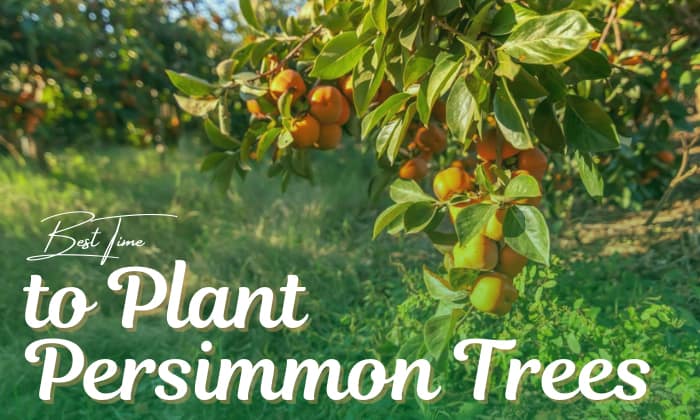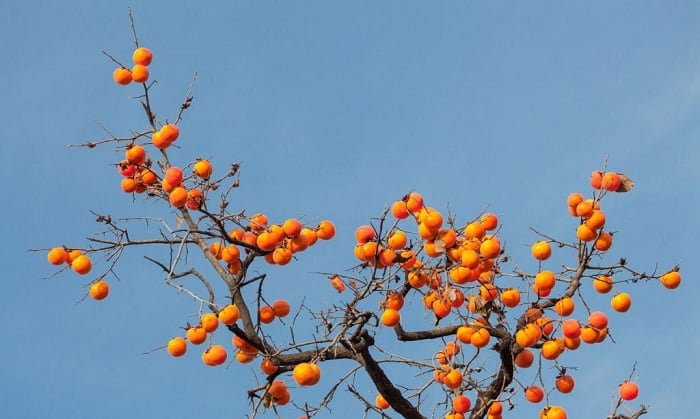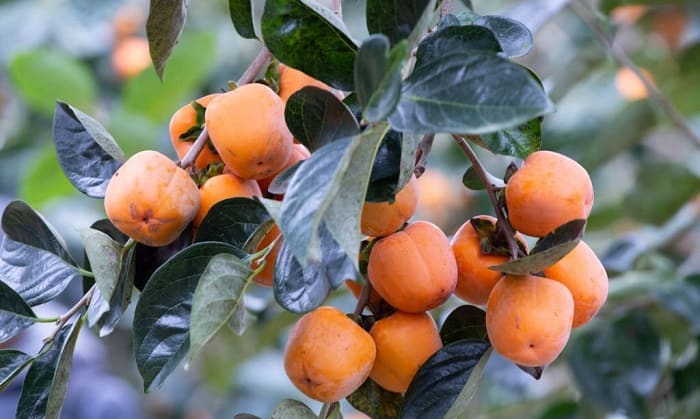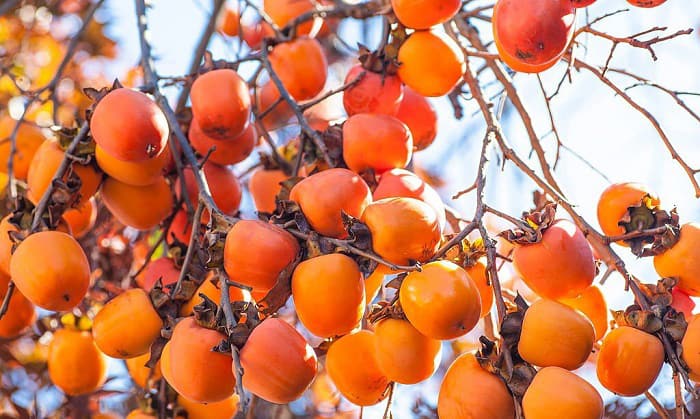While planning your fall garden, perhaps you’ve thought of growing flowers like pansies, asters, and sedums. After all, they are vibrant and pretty enough to decorate any yard.
And if you want a fruit tree to complement these flowers, persimmons are an excellent choice. Not only do they look beautiful, but they also produce tasty fruits that go well in many dishes.
But when to plant persimmon trees? It’s best to grow them in spring or fall when there’s no frost. In spring, this timeframe would be around December to June, depending on your last frost date. In addition, it’s also possible to transplant persimmon trees six weeks before the first frost date in the fall.
As for summer, the ideal months for growing persimmons are late June to early August.
Table of Contents
When to Grow Persimmon Trees?
It’s practical to grow persimmon trees when there’s no frost, since warm soil is much easier to work with than frozen ground.
Plus, despite having excellent cold tolerance, persimmons need time to spread their roots in the summer or fall before extreme freezes arrive, and winter is often their dormancy period.
Therefore, whether you grow Asian or American persimmons, it’s vital to note down their temperature limits.
Asian or Japanese varieties can withstand 0°F at best, though you may find some exceptions that are more resilient. Meanwhile, their American counterparts are much more tolerant of cold weather, capable of surviving -25 degrees.
It’s critical not to subject persimmons to temperatures below these points, or they’ll end up dead.
Now that you know the reasons behind the persimmon plant gardening calendar, keep in mind these guidelines:
- People rarely grow persimmons from seeds, since they are less likely to produce plants identical to the original trees. Getting seeds to sprout is also harder than tending to seedlings or grafted persimmons.
- So, buy some transplants and move them outside right after the last frost. Note that the best temperature range for persimmons is 55 to 66℉.
- Set them into the garden as soon as possible, since more mature saplings will have extensive roots that are vulnerable to disturbance.
- If you grow persimmons in the fall, plant them six weeks before the first frost to give them enough time to establish.
- Finally, if you choose to plant persimmon seeds instead of grafted trees or seedlings, put them in a jar with wet paper towels and stratify them for 3 months. Afterward, sow them in pots containing a seed starting mix and perlite in a 1:1 ratio.
- Throughout the cold treatment and sowing periods, the towel or planting medium should be moist but not soggy. The persimmon containers should receive six hours of direct sunshine after germination.
Plus, the soil should measure 46 to 50 degrees Fahrenheit to facilitate growth, with 70 degrees being ideal.
- Finally, harden off the seeded plant for seven days, then move it outside after the last frost.
Types of Persimmons
Aside from their gardening time, you may want to learn about different types of persimmons as well. Such information can help you select the cultivar that suits your needs.
On the whole, there are three main persimmon varieties: Asian or Japanese, American or common, and Mexican persimmons. The first two are predominant in the US, so we’ll focus on comparing them here.
Fruit production
Is persimmon tree self pollinating? Asian varieties will self-pollinate, so you don’t need to grow separate male and female plants to enjoy their fruits. The opposite applies to American cultivars, which often require at least two trees to bear fruits.
As you may have guessed, American persimmons take up more space than their Asian counterparts. On top of accounting for their substantial size, you’ll need to grow two common persimmons, meaning more gardening work.
The only way to circumvent this problem is by putting two pruned trees in one garden plot or using a female tree with a male branch.
However, both methods may be more troublesome than planting an Asian persimmon.
Growing zone
Where to plant persimmon trees? If you’re going for an American variety, zone 5 to 9 is your best bet. For example, if you live in Indiana, Pennsylvania, or Oklahoma, your common persimmon should grow just fine.
On the other hand, Asian or Japanese persimmons will suit zones 7 to 11 more. That means gardeners in Texas (its eastern part, to be specific), plus west-central and coastal Oregon, will have no trouble planting them.
Texture and flavor
Last but not least, consider your palate before picking which persimmon to grow. American varieties are astringent, meaning they are soft when ripe and unsuitable for people who like crunchiness.
Japanese persimmons, meanwhile, can be either astringent or non-astringent. Thus, people can allow them to soften with time or eat them while their skin is tough.
Flavor-wise, American persimmons are much sweeter and more complex. While Japanese cultivars are sweet as well, they don’t have the creamy and tangerine-like notes commonly seen in their common counterparts.
How to Plant Persimmon Trees?
Since persimmons best grow from grafted trees, we’ll focus on them here. To plant grafted persimmons, keep in mind the following tips:
- Give the plants at least six hours of direct sunshine, and put them somewhere with sufficient vertical clearance. If your tree grows very tall, you don’t want it to hit electrical cables.
- Also, ensure there’s no detritus and weed within a four-foot radius of the tree, though three feet should also be acceptable. You can cut grass and weed with a spade and remove them by hand, but not before watering them the previous day.
- Once that’s taken care of, check your soil to see if it has the pH, spacing, compost, and planting hole described in the FAQ below.
- Then, remove any damaged roots from the persimmon tree and embed it in the hole.
- Proceed to fill the hole with soil and compost, but make sure not to cover the graft union or the lumpy section where the scion and rootstock connect. In fact, leave this part at least 6 inches above the ground.
- Step on the soil lightly with your feet, and irrigate it slowly with five gallons of water.
- After transplanting, water the persimmon once every three to four days for the first six weeks; just make sure the soil doesn’t stay dry for long, and you should be okay.
- Once the tree has settled into the ground, an inch of water per week will suffice. Double the amount if grown on sandy soil.
FAQs
How to eat persimmons?
Astringent persimmons are edible only when they’re ripe or soft. To enjoy these fruits, just cut them and remove the seeds before eating. Do the same steps to try out non-astringent varieties, but note that they should be firm for ideal taste.
With both types, you can add cream or sugar for extra flavors and incorporate them into salads, cookies, jams, etc.
Where is the best place to plant a persimmon tree?
To grow persimmons, your garden bed should have the following attributes:
- Loamy, well-drained soil with a pH of 6 to 6.5
- Four to six inches of mulch with hay, compost, and pine bark
- Adequate persimmon tree spacing (10 to 50 feet between plants, with bigger trees needing more space). A dwarf persimmon tree like Ichi Ki Kei Jiro, for instance, needs 10 feet of clearance only, while an American cultivar requires at least 30 feet.
- The hole for planting should be three times wider than the seedling or tree. There should be enough soil to cover the roots of the persimmon but not its crown.
- There hasn’t been any tree that perished in the planting spot recently.
How long does it take for a persimmon tree to give fruit?
The growth rate of persimmons isn’t very fast, at least when it comes to fruiting. Here are the lengths of time necessary for these plants to produce edible crops:
- Asian persimmons – seven years
- American persimmons – ten years
- Grafted or bare-root trees – at least three years
Note that fruiting can be intermittent if the tree lacks water or incurs stress while developing.
What is the best time to plant a Fuyu persimmon tree?
The best time for growing Fuyu persimmons is in spring or fall, under frost-free weather. This fact is true regardless of the variety you opt for.
Conclusion
Whether you grow persimmons for deer or for yourself, we hope you found this article helpful.
Follow our guidelines above, and you’ll be able to enjoy the sight of persimmons in your garden – no need to look at online pictures of a persimmon tree.
Do you have any questions about this topic? Have you decided when to plant persimmon trees? Feel free to let us know.
Read more other topics related to planting calendar:

Hi, I am William – Floridayards’ digital content creator. My job is to find answers to all your concerns with thorough research and our team’s expert advice. I will also bring you honest reviews on the best products and equipment for raising your beautiful garden. Please look forward to our work!














